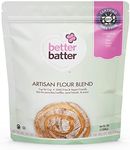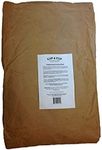Buying Guide for the Best Gluten Free Flours
Choosing the right gluten-free flour can make a big difference in your cooking and baking results. Gluten-free flours come from a variety of grains, nuts, and seeds, each with its own unique properties. Since they behave differently from traditional wheat flour, it's important to understand what each type offers and how it fits your needs. Think about what you plan to make, any allergies or sensitivities you have, and the texture or flavor you want in your final product. Experimenting with blends or single flours can help you find the best fit for your recipes.Source IngredientThe source ingredient refers to what the flour is made from, such as rice, almonds, coconut, chickpeas, or oats. This is important because each source brings its own flavor, texture, and nutritional profile. For example, almond flour is nutty and moist, while rice flour is neutral and light. If you have allergies or dietary preferences, always check the source. If you want a mild taste, go for rice or oat flour; for richer flavor, try almond or coconut. Your choice should match the recipe and your personal taste preferences.
Texture and FinenessTexture and fineness describe how smooth or coarse the flour is. This matters because it affects the final texture of your baked goods. Fine flours are best for cakes and pastries, giving a soft crumb, while coarser flours work well in breads or rustic recipes. If you want a delicate, smooth result, look for finely milled flours. For hearty, dense products, a coarser grind is suitable. Think about what you’re making and choose the texture that matches your desired outcome.
Binding AbilityBinding ability is how well the flour helps hold ingredients together, which is especially important in gluten-free baking since there’s no gluten to provide structure. Some flours, like chickpea or sorghum, have better binding properties, while others, like rice or corn, may need to be mixed with binders like xanthan gum or eggs. If you’re making bread or pizza dough, choose a flour with good binding or plan to add a binder. For cookies or pancakes, less binding is usually needed.
Flavor ProfileFlavor profile refers to the taste the flour adds to your food. Some gluten-free flours, like coconut or buckwheat, have strong, distinctive flavors, while others, like white rice or tapioca, are more neutral. If you want the flour to blend in, pick a mild one. If you want to add a specific taste, choose a flour with a pronounced flavor. Consider the recipe and whether you want the flour to stand out or stay in the background.
Nutritional ContentNutritional content covers the vitamins, minerals, protein, and fiber in the flour. Some gluten-free flours, like quinoa or teff, are high in protein and nutrients, while others, like potato or tapioca, are mostly starch. If you’re looking to boost nutrition, choose flours with higher protein and fiber. If you’re making a treat or need a light texture, a starchier flour may be better. Match the nutritional profile to your health goals and the role the flour plays in your diet.















